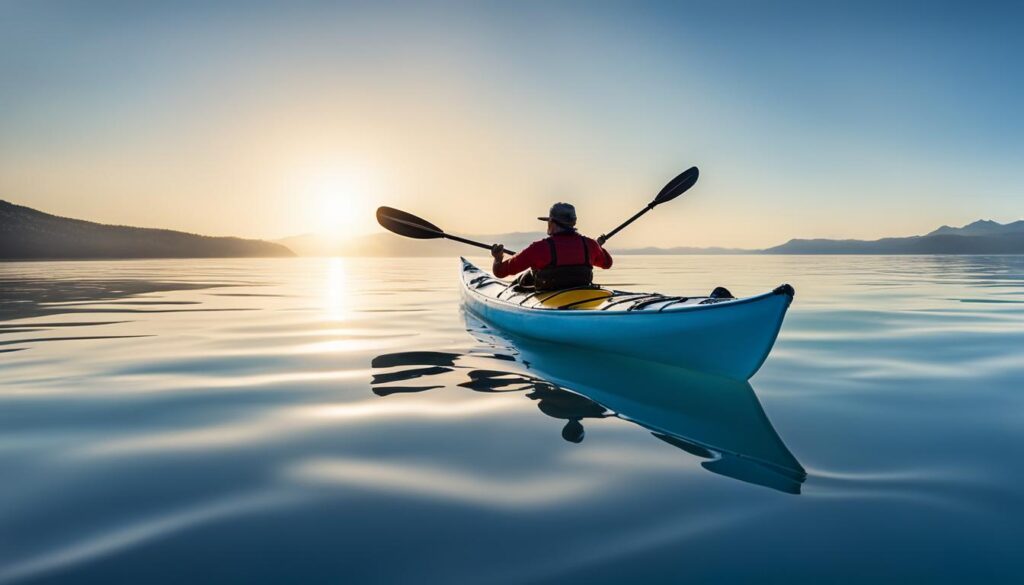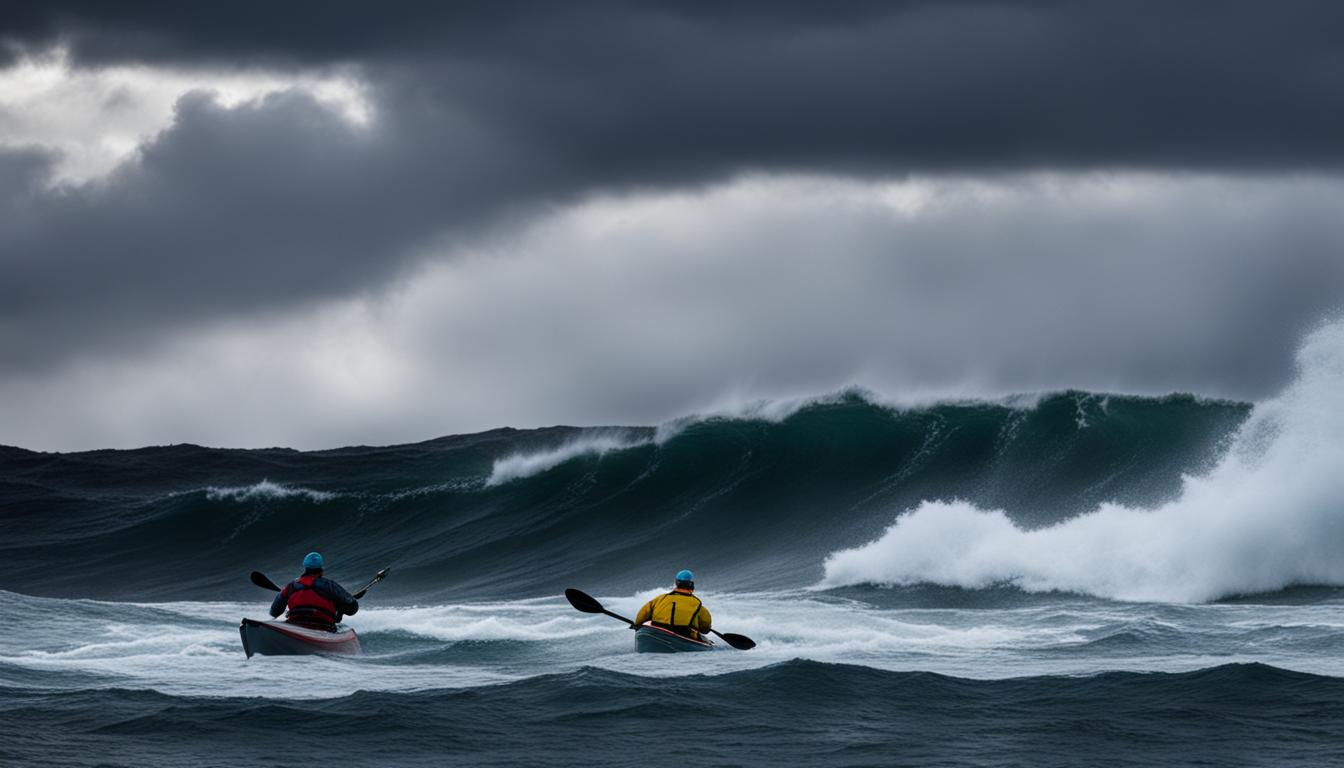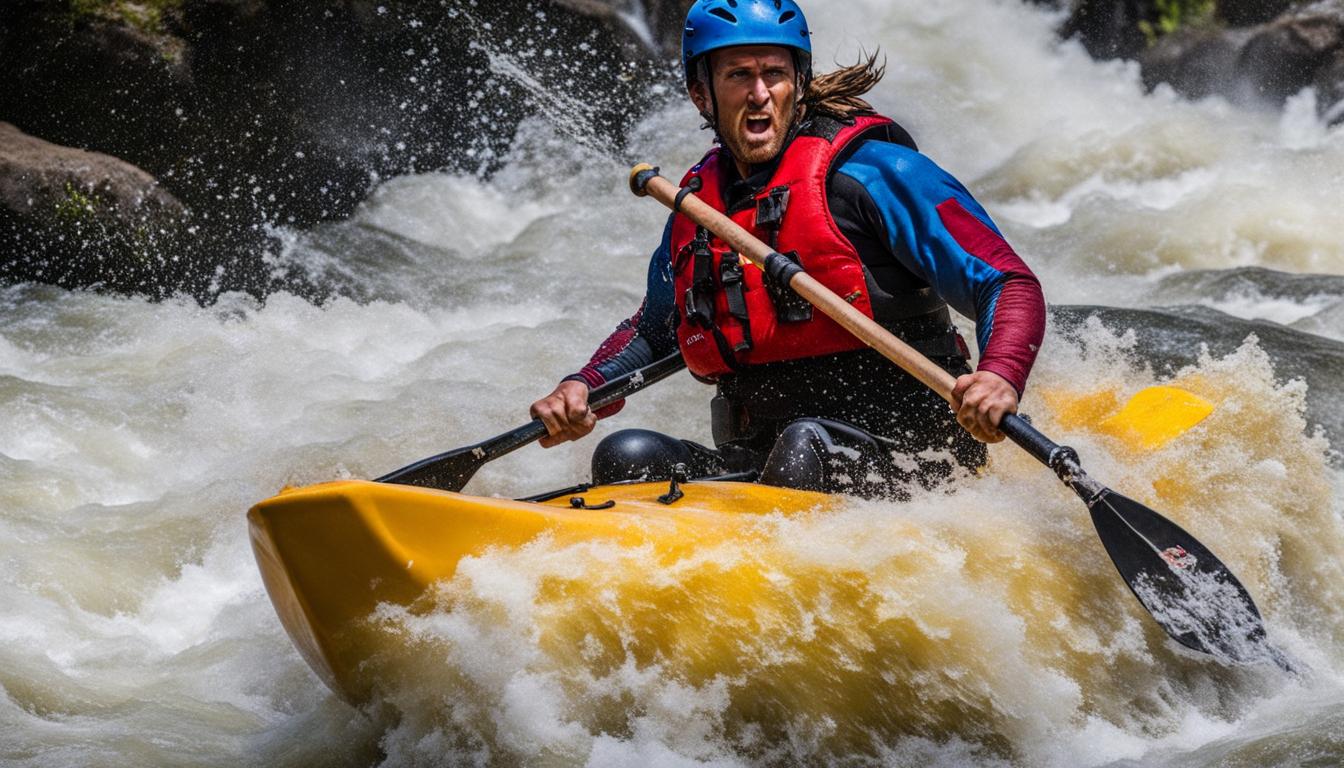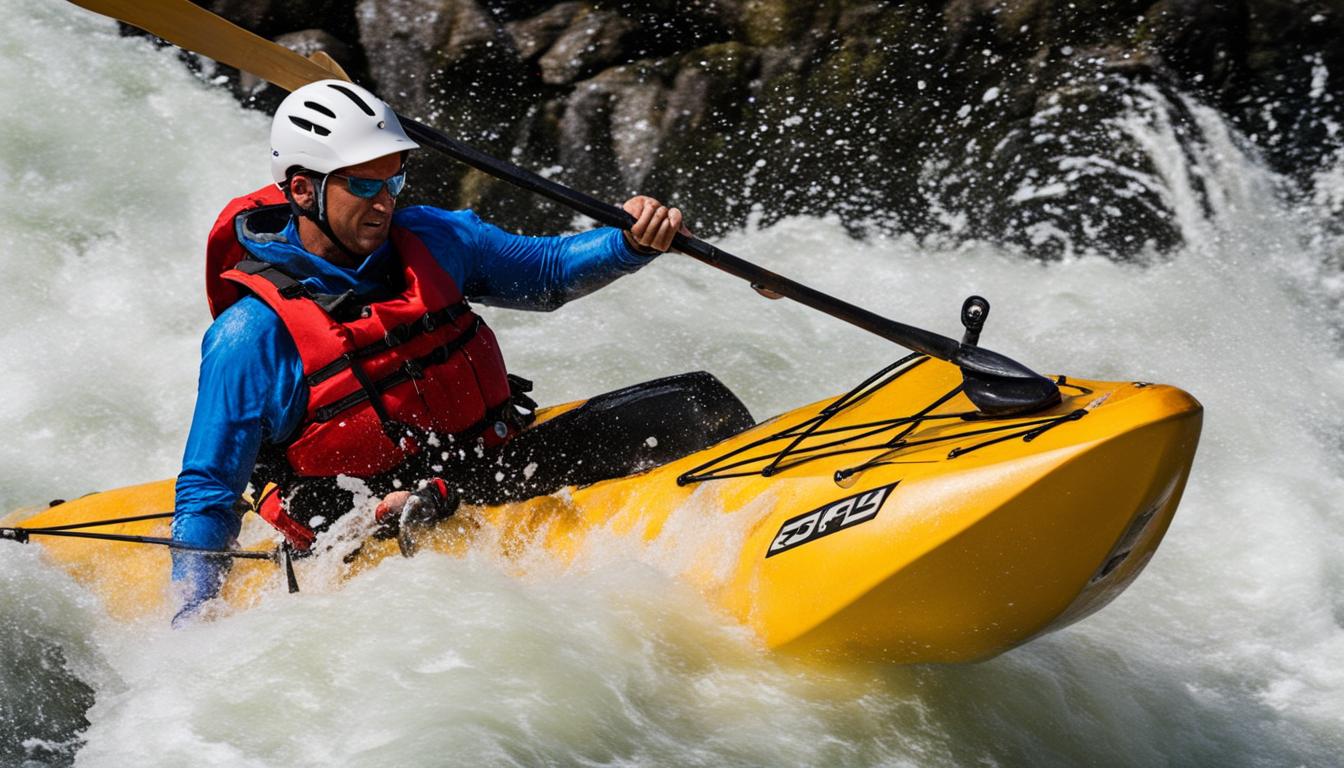Embarking on a sea kayaking adventure can be an exciting and invigorating experience. However, it is essential to be aware of the potential dangers that can arise and take the necessary precautions to ensure a safe and enjoyable journey. By understanding these dangers and implementing effective risk management strategies, you can minimize the risks involved and fully embrace the beauty of sea kayaking.
Sea kayaking is an activity that requires careful attention to safety. Avoiding hazards and practicing risk management should be top priorities for any kayaker. By being proactive and knowledgeable, you can navigate the waters with confidence and peace of mind.
Key Takeaways:
- Understanding the potential dangers in sea kayaking is crucial for your safety.
- Implementing effective risk management strategies can minimize the risks involved.
- Awareness of hazards and practicing safety measures is essential for an enjoyable experience.
- Take the necessary precautions and stay informed about weather conditions and wildlife in the area.
- Ensure you have the right equipment and clothing to enhance your safety on the water.
Importance of Kayak Safety
When it comes to sea kayaking, safety should always be your top priority. Understanding and preventing accidents while kayaking is key to ensuring a safe and enjoyable experience on the water. By being aware of the potential hazards and adopting safe practices, you can greatly reduce the risk of incidents and make the most out of your sea kayaking adventures.
One of the first steps in kayak safety is hazard identification. Familiarize yourself with the environment you’ll be kayaking in and be aware of any potential dangers such as strong currents, unstable weather conditions, or rocky coastlines. By acknowledging these hazards, you can take appropriate precautions and make informed decisions regarding your route and timing.
In addition to hazard identification, it is crucial to follow safe practices while sea kayaking. Always wear a properly fitted buoyancy aid or life jacket to ensure flotation and increase your chances of survival in case of an accident. It is also recommended to paddle with a buddy or in a group, as there is safety in numbers. Communicate your plans with someone on land and establish a system for regular check-ins to ensure that help can be alerted if needed.
Furthermore, acquiring the necessary skills and knowledge is vital for safe sea kayaking. Take the time to learn proper paddle techniques, self-rescue methods, and how to navigate in different conditions. Attending a kayaking course or seeking guidance from experienced kayakers can greatly enhance your safety and confidence on the water.

Safe Practices in Sea Kayaking:
- Wear a properly fitted buoyancy aid or life jacket at all times.
- Paddle with a buddy or in a group for increased safety.
- Communicate your plans with someone on land and establish a check-in system.
- Identify and avoid potential hazards in the environment.
- Acquire the necessary skills and knowledge for safe kayaking through courses or guidance from experienced kayakers.
By prioritizing kayak safety and following these guidelines, you can minimize the risk of accidents and enjoy a safe and memorable sea kayaking experience.
Tips for Safe Sea Kayaking
When it comes to sea kayaking, safety should always be your top priority. By following these essential tips and strategies, you can ensure a safe and enjoyable experience on the water.
1. Get Proper Training and Skill Development
Before embarking on any sea kayaking adventure, it is crucial to acquire the necessary skills and knowledge. Consider taking a kayaking course or hiring a professional guide to ensure you are well-prepared. Learn how to paddle efficiently, perform self-rescue techniques, and navigate through different water conditions.
2. Check the Weather and Forecast
Always check the weather forecast before heading out. Pay attention to wind speed, barometric pressure, and potential storms. Avoid kayaking in severe weather conditions, strong currents, or high winds. Plan your trips during more favorable weather conditions to minimize risks.
3. Wear Appropriate Safety Gear
Invest in high-quality safety gear and always wear a properly fitted buoyancy aid or life jacket. Additionally, wear appropriate clothing to protect yourself from sunburn and cold temperatures. Don’t forget to wear a helmet for added head protection.
Remember that accidents can happen, even to experienced kayakers, so it’s crucial to be prepared. Carry a first aid kit, signaling device, and a spare paddle. Keep a whistle or air horn within reach in case you need to attract attention. Additionally, consider using a leash to secure your paddle to your kayak to prevent it from drifting away during mishaps.
By implementing these safety precautions and strategies, you can ensure a safe and enjoyable sea kayaking experience. Always be vigilant, aware of your surroundings, and prepared for any unforeseen circumstances that may arise.
| Tips for Safe Sea Kayaking | |
|---|---|
| Get Proper Training and Skill Development | Prioritize your safety by acquiring the necessary skills and knowledge through kayaking courses or professional guides. |
| Check the Weather and Forecast | Stay informed about weather conditions, wind speed, and potential storms to avoid kayaking in dangerous situations. |
| Wear Appropriate Safety Gear | Invest in high-quality safety gear, including buoyancy aids, helmets, and proper clothing to protect against sunburn and cold temperatures. |
“Safety isn’t expensive, it’s priceless. Prioritize your safety by following the right precautions and always being prepared.” – Anonymous
The Importance of Weather and Environment Safety
When it comes to sea kayaking, being aware of weather and environmental conditions is vital for your safety. By understanding and preparing for factors such as water temperature, wildlife, and weather patterns, you can ensure a smooth and secure kayaking experience.
Water Temperature Awareness
Water temperature is a crucial consideration for sea kayakers. Cold water can pose a significant risk, even in warmer air temperatures. Hypothermia can set in quickly, leading to loss of coordination and consciousness. To protect yourself, check the water temperature prior to your kayaking adventure and dress accordingly. Wearing a wetsuit or drysuit can help maintain body heat and prevent hypothermia. It’s also a good idea to carry a change of clothes in a waterproof bag in case you do get wet.
Wildlife Navigation
Encountering wildlife while sea kayaking can be an awe-inspiring experience, but it’s crucial to navigate these encounters safely. Research the area you plan to kayak in to determine what kind of wildlife you may encounter and learn about their behaviors. This knowledge will help you avoid potentially dangerous situations. Remember to respect the animals’ space and observe from a distance. Avoid paddling too close or disturbing their habitats. Stay visible by wearing bright colors or reflective gear, which can prevent accidental collisions with marine creatures or other watercraft.
Kayaking Weather Safety
Paying close attention to weather forecasts is essential before embarking on a sea kayaking trip. Check local marine and weather reports to stay informed about any changes in conditions, such as strong winds, storm warnings, or rough seas. It’s advisable to choose calm weather conditions with minimal wind and waves for a safer paddling experience. Planning your kayaking trips during daylight hours ensures better visibility and reduces the risk of getting caught in dangerous weather situations.
| Weather Condition | Recommended Action |
|---|---|
| Strong Winds | Avoid kayaking as it can make paddling and navigation difficult |
| Storms or Thunderstorms | Stay off the water to avoid lightning strikes and rough water conditions |
| Rough Seas | Postpone your kayaking trip until the water conditions calm down |
By prioritizing weather and environment safety, you can enjoy your sea kayaking adventures with peace of mind. Remember to stay informed about water temperature, respect wildlife, and make informed decisions based on weather conditions. With proper preparation and awareness, you’ll have a safe and enjoyable time on the water.

Essential Equipment for Kayak Safety
When it comes to sea kayaking, having the right equipment is crucial for ensuring your safety on the water. Proper gear can protect you from the elements, enhance your experience, and provide peace of mind. Here’s a breakdown of the essential equipment you’ll need to stay safe while kayaking:
Kayaking Clothing
- Appropriate clothing for kayaking is essential to protect yourself from sunburn, cold temperatures, and water splashes. Consider wearing a dry or wet suit, depending on the water temperature. These suits provide insulation and keep you warm even in chilly conditions. Don’t forget to wear a hat and long-sleeved shirt for added sun protection.
- Invest in a pair of water shoes or neoprene booties to protect your feet and provide traction on slippery surfaces.
Personal Safety Gear
- A properly fitted buoyancy aid or life jacket is a must-have for every kayaker. It will keep you afloat in case of an emergency and provide extra security.
- Always wear a helmet, especially if you plan on challenging yourself with advanced kayaking techniques or navigating rapids.
Kayak and Paddle
- Choose a kayak that suits your needs and skill level. There are various types available, such as recreational kayaks, touring kayaks, and sea kayaks. Ensure that your kayak is stable, maneuverable, and properly maintained.
- Invest in a quality paddle that is the right length for your height and the type of kayaking you’ll be doing. A lightweight and durable paddle will make paddling easier and more enjoyable.
Navigation and Communication Devices
- Carry navigation devices such as maps, compasses, and GPS systems to help you navigate safely and reach your destination.
- Communication devices like cell phones or radios can be handy in case of emergencies or if you need to contact someone on land.
| Equipment | Importance |
|---|---|
| Kayaking Clothing | Protects against sunburn, cold temperatures, and water splashes |
| Personal Safety Gear | Includes buoyancy aid or life jacket and helmet for added safety |
| Kayak and Paddle | Choose a stable, maneuverable kayak and invest in a quality paddle |
| Navigation and Communication Devices | Aids in safe navigation and communication with others |
By equipping yourself with the right gear, you’ll be ready to take on the challenges of sea kayaking while ensuring your safety. Remember to always check that your equipment is in good condition before heading out, and never underestimate the importance of preparation and safety precautions. Happy and safe kayaking!
Conclusion
In conclusion, ensuring kayak safety is of utmost importance when engaging in sea kayaking. By being aware of the potential dangers and taking preventive measures, you can greatly reduce the risks and enjoy a safe and enjoyable experience. Remember, safety should always be your top priority.
Understanding and implementing risk management strategies, following safety guidelines, and wearing appropriate equipment are key factors in minimizing accidents and injuries. It is crucial to stay informed about weather conditions, water temperatures, and potential hazards in your kayaking environment. Being prepared and equipped with the right gear can make all the difference in keeping yourself and others safe.
Always remember that sea kayaking can be unpredictable, and unforeseen circumstances may arise. Therefore, it is essential to maintain a cautious and responsible approach throughout your kayaking journey. By doing so, you can fully embrace the exhilarating beauty of sea kayaking while ensuring a safe and enjoyable experience for yourself and those around you.
FAQ
What are the potential dangers of sea kayaking?
Sea kayaking can pose risks such as accidents, injuries, and even fatalities if safety precautions are not followed.
How can I enhance safety while sea kayaking?
To enhance safety, you should check weather forecasts, dress appropriately, avoid areas with heavy watercraft traffic, and prioritize daylight hours for your trips.
What equipment do I need for kayak safety?
It is important to wear appropriate clothing, including dry or wet suits, hats, long-sleeved shirts, a helmet, and a buoyancy aid or life jacket. Additionally, carry navigation devices, communication devices, and supporting items like a backrest and dry bag.
Why is prioritizing kayak safety important?
Prioritizing kayak safety is crucial for ensuring an enjoyable and incident-free sea kayaking experience. It helps minimize the risks involved and keeps you and others safe.
How can I prevent accidents while kayaking?
By understanding the dangers, implementing safety precautions, and using appropriate equipment, you can greatly reduce the risk of accidents while sea kayaking.





